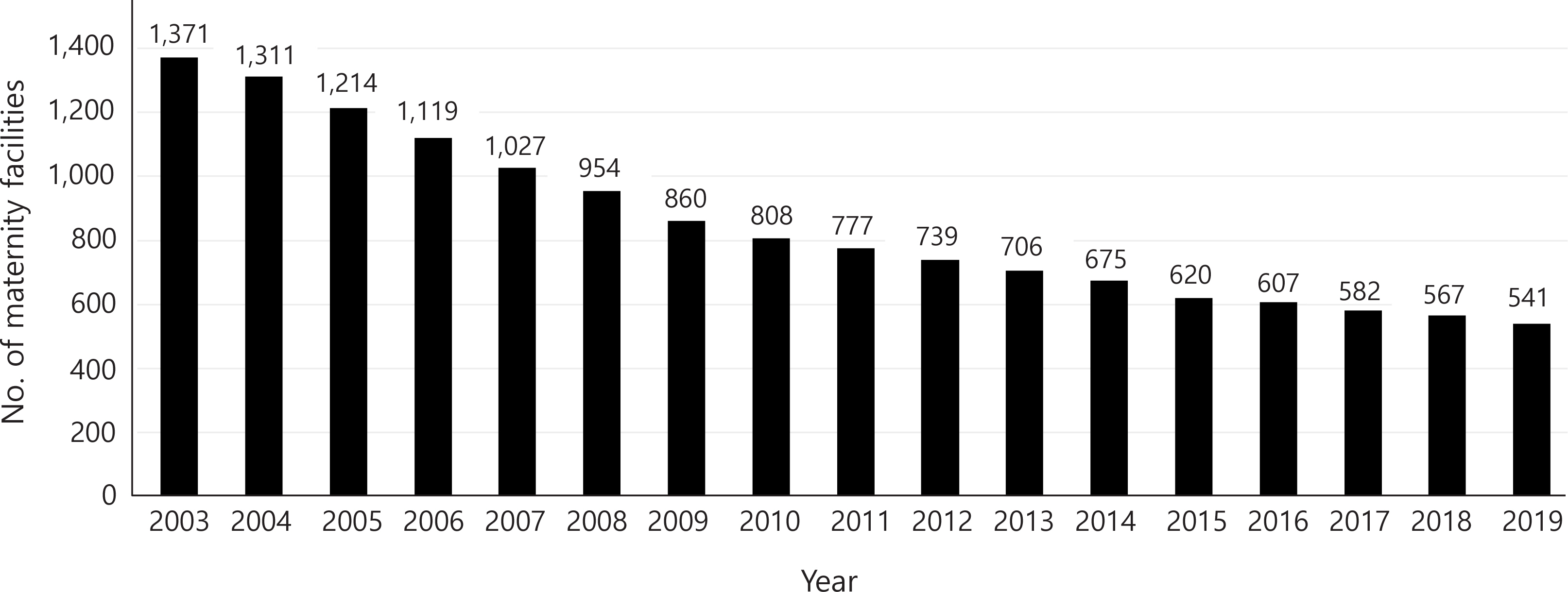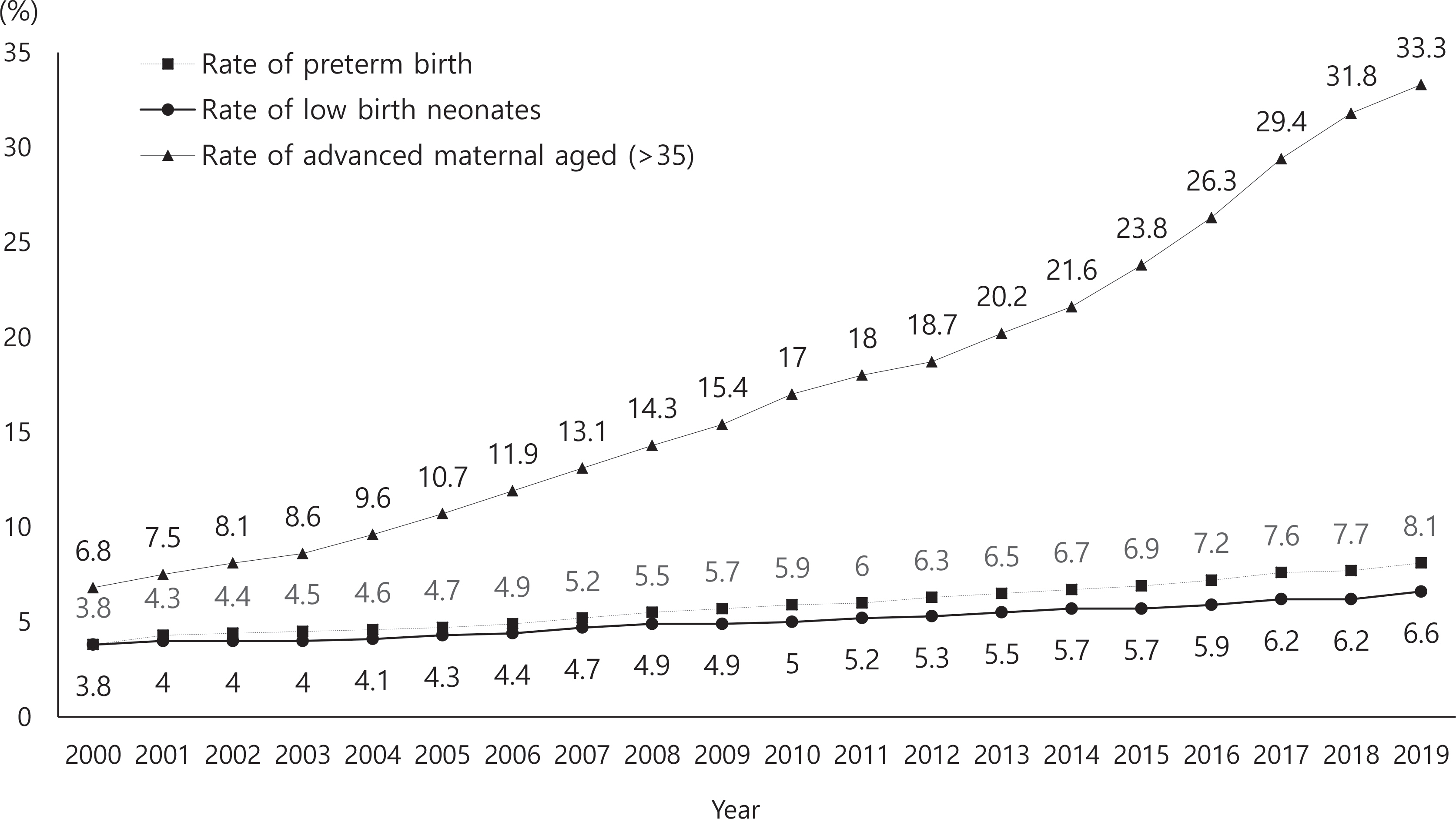J Korean Soc Matern Child Health.
2021 Oct;25(4):250-259. 10.21896/jksmch.2021.25.4.250.
Limitation and Improvement Plan of Maternity Healthcare Delivery System in Korea
- Affiliations
-
- 1Department of Obstetrics and Gynecology, Kangwon National University School of Medicine, Chuncheon, Korea
- KMID: 2521993
- DOI: http://doi.org/10.21896/jksmch.2021.25.4.250
Abstract
- The Korean healthcare delivery system has been operating for over 30 years since 1989. Despite a positive performance—providing quality medical services to the people by distributing medical resources—there are limitations to the maternity healthcare delivery system. If the maternity healthcare delivery system was operating successfully, there should have been sufficient delivery hospitals so that pregnant women can access the appropriate maternity medical services whenever needed. Unfortunately, according to the National Health Insurance Service, the number of maternity health facilities in Korea reduced from 1,371 in 2003 to 541 in 2019. Regrettably, a larger number of obstetric hospitals and clinics have closed in medically vulnerable areas, such as farming and fishing areas, than urban areas with sufficient medical infrastructure, creating obstetrically underserved areas. In 2020, 65 out of a total of 250 cities, counties, and districts had no obstetric hospitals or clinics. To improve the collapsing maternity healthcare delivery system, a different approach is required; one in which policy support to stop the closure of delivery hospitals is emphasized. New maternity-related medical insurance payments, such as delivery labor management fees, fetal heart monitoring reading fees, and newborn care in delivery rooms fees, and active support policies are needed to prevent the closure of delivery hospitals. In this era of low fertility, because the maternity healthcare system is essential to maintain the nation, a healthcare delivery system different from the existing one must be established.
Figure
Cited by 2 articles
-
Maternal, infant, and perinatal mortality statistics and trends in Korea between 2018 and 2020
Hyunkyung Choi, Ju-Hee Nho, Nari Yi, Sanghee Park, Bobae Kang, Hyunjung Jang
Korean J Women Health Nurs. 2022;28(4):348-357. doi: 10.4069/kjwhn.2022.12.23.A Maternity Waiting Home Is an Alternative Approach for the Accessibility of Pregnant Women in an Obstetrically Underserved Area of Korea
Yeon-Jin Kim, Lan Li, Jong Yun Hwang
J Korean Med Sci. 2023;38(17):e164. doi: 10.3346/jkms.2023.38.e164.
Reference
-
Ahn TG., Hwang JY. Maternity care system for high risk preg-nant women in obstetrically underserved area. J Korean Med Assoc. 2016. 59:436–42.
ArticleAhn TG., Hwang JY. Secure plan of appropriate obstetricians and nurses for safe childbirth in Korea. J Korean Soc Matern Child Health. 2017. 21:14–23.Ahn TG., Kim TY., Kim YJ., Hwang JY. The current state of maternity care and suggestions for improvement in the management of high-risk pregnancies in South Korea. J Korean Soc Matern Child Health. 2018. 22:134–41.Cho BG., Lee SI., Jo NW., Ahn JH., Lee YR., Oh IH. Cost of ill-ness due to maternal disorders in Korea. J Health Tech Assess. 2018. 6:123–32.Choi S., Lee KS. The spatial accessibility of women in child-bearing age for delivery services in Gangwon-do. Health Policy Manag. 2017. 27:229–40.Choi YH., Na BJ., Lee JY., Hwang JH., Lim NG., Lee SK. Obstetric complications by the accessibility to local obstetric service. J Agric Med Community Health. 2013. 38:14–24.
ArticleHwang JY. Comprehensive care of high-risk pregnancy for reducing maternal mortality – a proposal to establish a Korean pregnancy and birth registry. J Korean Soc Matern Child Health. 2015. 19:163–71.Hwang JY. Reclassification of high-risk pregnancy for maternal-fetal healthcare providers. J Korean Soc Matern Child Health. 2020. 24:65–74.
ArticleHwang JY. Renovation of maternal-child healthcare centers and the national maternal-child medical center based on the Mother and Child Act. J Korean Soc Matern Child Health. 2019. 23:7–12.Kwak MY., Lee SM., Lee TH., Eun SJ., Lee JY., Kim Y. Accessi-bility of prenatal care can affect inequitable health outcomes of pregnant women living in obstetric care underserved areas: a nationwide population-based study. J Korean Med Sci. 2018. 34:e8.
ArticleLee JY., Jang MW., Kim KY., Yun SM., Lee JH., Jeong J, et al. Accessibility of the disabled to Health Care Institution: a case study of Chongno-gu in Seoul. Health Policy Manag. 2006. 16:19–36.Lee KJ., Sohn S., Hong K., Kim J., Kim R., Lee S, et al. Maternal, infant, and perinatal mortality statistics and trends in Korea between 2009 and 2017. Obstet Gynecol Sci. 2020. 63:623–30.
ArticleLee SJ., Li L., Hwang JY. After 20 years of low fertility, where are the obstetrician-gynecologists? Obstet Gynecol Sci. 2021. 64:407–18.
ArticleLee SM. Essential health care Korea. J Korean Med Assoc. 2019. 62:231–7.Lee SY., Chang YS., Lee SS., Lee CH., Shin SM., Shin SH, et al. Population change and future social policy directions. Se-jong (Korea): Korea Institute for Health and Social Affairs;2019.Ministry of Health and Welfare. Introduction of Obstetrically Underserved Areas Support Project. Sejong (Korea): Ministry of Health and Welfare;2021.Na BJ., Kim HJ., Lee JY. An early stage evaluation of the Sup-porting Program for Obstetric Care Underserved Areas in Korea. J Korean Med Sci. 2014. 29:764–70.
ArticleOrganization for Economic Co-operation and Development. Health status: maternal and infant mortality [Internet]. Paris: Organization for Economic Co-operation and De-velopment;c2016. [cited 2021 Apr 18]. Available from: https://stats.oecd.org/index.aspx?queryid=30116.Park HS., Kwon HY. Analysis of the causes and trends of ma-ternal mortality in Korea: 2009-2014. Korean J Perinatol. 2016. 27:110–7.
ArticleStatistics Korea. Infant/maternal death [Internet]. Daejeon (Korea): Statistics Korea;2021. [cited 2021 Apr 18]. https://www.index.go.kr/potal/main/EachDtlPageDetail.do?idx_cd=2769.World Health Organization. Pregnant women must be able to access the right care at the right time, says WHO [internet]. Geneva (Switzerland): World Health Organization;c2016. [cited 2021 Apr 18]. Available from: https://www.who.int/home/07-11-2016-pregnant-women-must-be-able-to-access-the-right-care-at-the-right-time-says-who.Yu SH. Medical comunication system and hospital management under the national health insurance system. J Korean Hos pital Assoc. 1988. 17:34–40.Yun GJ., Oh YH., Lee SY., Ha SE., Yeo JY., Kim JH, et al. Issues and improving strategies on Korean Healthcare Delivery System. Sejong (Korea): Korea Institute for Health and Social Affairs;2014.
- Full Text Links
- Actions
-
Cited
- CITED
-
- Close
- Share
- Similar articles
-
- Can an Increase in Delivery Medical Fees Prevent the Collapse of the Maternity Infrastructure System?
- Renovation of Maternal-child Healthcare Centers and the National Maternal-child Medical Center Based on the Mother and Child Act
- Establishment of Healthcare Delivery System through Improvement of Health Insurance System
- Improvement Plan of Healthcare Delivery System in Korea
- A proposal for the disruptive innovation of healthcare delivery system in Korea



